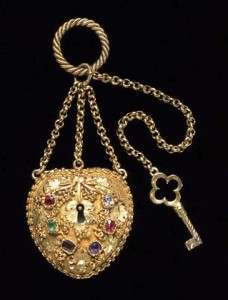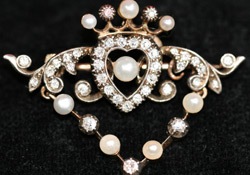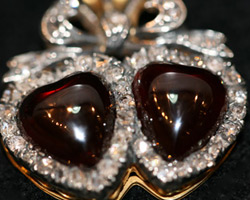In the last post I touched on the less overt love tokens.
One of the loveliest I always thought was Regard jewellery, which found favour during the late Georgian and Victorian times. This is where the stones in the ring or locket, for example, spell the message regard (Ruby, Emerald, Garnet, Amethyst, Ruby and Diamond) or dearest (Diamond, Emerald, Amethyst, Ruby,

Emerald, Sapphire and Topaz.) It sounds ghastly and in modern jewellery the colours clash appallingly but in antique jewellery the stones are often combined with different shades of gold so the effect is more muted. This early Victorian padlock and key jewel combines the symbolism of having the key to unlock the heart’s secrets with the charm of the message.
For most, the ultimate symbol of love is the wedding ring, (the gotcha symbol). It has, though, gone through many transformations. to arrive at today’s wedding band. A simple twisted hemp ring sufficed in ancient civilisations, an iron ring in the early Roman period (which symbolised the man’s ownership of the woman). However, a more attractive Roman development of the marriage ring was a fede ring. Fede comes from the Latin for trust, faith and fidelity. This sign of two hands joined together was the Roman emblem for a legal contract, (perhaps the modern equivalent of shaking hands on a deal). This ring has kept this essential meaning of trust over the
many transformations. to arrive at today’s wedding band. A simple twisted hemp ring sufficed in ancient civilisations, an iron ring in the early Roman period (which symbolised the man’s ownership of the woman). However, a more attractive Roman development of the marriage ring was a fede ring. Fede comes from the Latin for trust, faith and fidelity. This sign of two hands joined together was the Roman emblem for a legal contract, (perhaps the modern equivalent of shaking hands on a deal). This ring has kept this essential meaning of trust over the
 centuries – Nelson gave his Emma a fede ring. A more popular version of this ring is this 17th century design – remarkably similar to the Irish Claddagh ring. The hands holding the heart make it a natural choice to represent sweethearts.
centuries – Nelson gave his Emma a fede ring. A more popular version of this ring is this 17th century design – remarkably similar to the Irish Claddagh ring. The hands holding the heart make it a natural choice to represent sweethearts.
 For me, though the most delightful wedding bands were always poesy rings. Often looking remarkably like plain modern wedding rings, the inside would be inscribed with some sort of message. Some messages had religious overtones such as ‘Fear God, and love me’ (written 1086) or were painfully honest such as ‘When the money’s low. This ring must go.’ (c.1595), while others were deliciously flirtatious such as, ‘Com kisse me daintilye.’ (c.1596). The
For me, though the most delightful wedding bands were always poesy rings. Often looking remarkably like plain modern wedding rings, the inside would be inscribed with some sort of message. Some messages had religious overtones such as ‘Fear God, and love me’ (written 1086) or were painfully honest such as ‘When the money’s low. This ring must go.’ (c.1595), while others were deliciously flirtatious such as, ‘Com kisse me daintilye.’ (c.1596). The
 significance of these secret mottos was supposed to be greatly enhanced because the words actually touched the recipient’s skin. (Perhaps this didn’t apply to the wearer of the painfully honest message). Poesy rings were particularly popular from the early Medieval period to Victorian times. Unfortunately, when the Hall Marking Act of gold wedding rings came into force in 1855 this attractive custom died. However, one can still find these old poesy rings around.
Of course, one doesn’t actually need a ring to get married. The Puritans in England tried to pass a law forbidding wedding rings as it smacked of the Papacy etc. They failed, but the remains of this attempt is that a ring does not have to be a part of a civil ceremony. One delightful anecdote incorporating this is that in America, the early Puritans gave a wedding thimble to the bride instead of a wedding ring. However, the bottom often ‘fell out’ of the thimble – so the wife was left with a ring anyway.
If you feel that discretion is not the better part of Valentine’s Day then here are some more traditional jewels.
significance of these secret mottos was supposed to be greatly enhanced because the words actually touched the recipient’s skin. (Perhaps this didn’t apply to the wearer of the painfully honest message). Poesy rings were particularly popular from the early Medieval period to Victorian times. Unfortunately, when the Hall Marking Act of gold wedding rings came into force in 1855 this attractive custom died. However, one can still find these old poesy rings around.
Of course, one doesn’t actually need a ring to get married. The Puritans in England tried to pass a law forbidding wedding rings as it smacked of the Papacy etc. They failed, but the remains of this attempt is that a ring does not have to be a part of a civil ceremony. One delightful anecdote incorporating this is that in America, the early Puritans gave a wedding thimble to the bride instead of a wedding ring. However, the bottom often ‘fell out’ of the thimble – so the wife was left with a ring anyway.
If you feel that discretion is not the better part of Valentine’s Day then here are some more traditional jewels.





Love the symbolism – adds so much more to the beauty of these wonderful pieces. Even the “…this ring must go”! Fascinating reading – more,please.